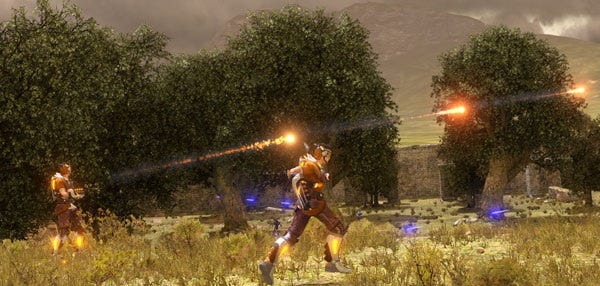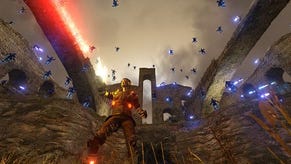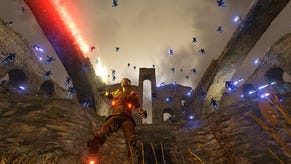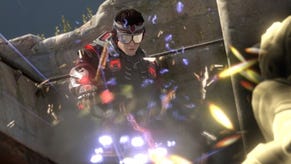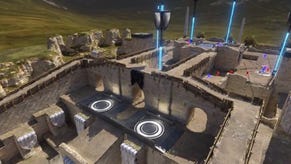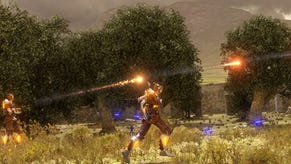Impressions – ShootMania: Storm
Man-shoot-mania
It’s exactly like that training course scene from Starship Troopers. The one with the non-lethal lasers, I mean. Not the one where a man gets shot to death in the skull during a live fire exercise. In ShootMania, nobody gets shot to death in the skull – that would be much too violent. Violence isn’t really what this particular FPS has in mind.
“Violence is a real limit for esports to grow,” says Florent Castelnerac, head of doing things at Nadeo. “I shouldn’t say that because it’s like saying Counterstrike is about terrorists – but it does limit esport.”
He talks about ShootMania appealing to people as a paintball-like sport rather than another violent war game. About how esport doesn’t need to be bloody and explosive to be engaging or competitive. His soothing French accent is dreamy.
But enough Francophilia. We’re four paragraphs deep and you want to know what this game is like. It’s good so far, if you must know, with lots of wholesome shooting at things. Trackmania gave players a basic racing game engine and handed them a toy box full of building blocks with which to make tracks. ShootMania is basically the same thing but instead of cars there are rockets and rail guns. And instead of building racetracks, you build your own combat arenas. As someone who spent weeks of time tinkering with the mapmaking modes of the Timesplitters series, I see this as a huge improvement. Racecar is my favourite palindrome but apart from that I want nothing more to do with motor vehicles. Not when someone with a French accent tells me I can build maps for a multiplayer first-person shooter instead.
Sadly, our demo didn’t let us muck about with the map-building components. Rather, we got stuck into the running and gunning of the game proper with a few maps that had already been made. Two teams of games journos, battling to the death. Like some kind of horrible dystopian night terror.
As with Trackmania, the focus on simplicity has not been lost. There are basically two buttons besides WASDling about. The left mouse fires off ‘rockets’ while the right mouse button jumps (you can also hold the right mouse button to start sprinting). That’s about it.
I put ‘rockets’ in inverted commas because they look more like long glowing energy projectiles. Yet it’s easy to see why Nadeo are calling them rockets to begin with. They fly across the map relatively slowly, like tracer rounds, so a lot of the game is anticipating exactly where your enemy will be in one or half a second’s time rather than where they actually are at the moment you pull the trigger.
Both firing and sprinting/jumping have separate energy bars. The stamina bar run out very quickly, as does the firepower bar (you can get about four or five rapid shots off before it’s empty) so timing is super important.
It takes a little bit to get used to jumping with the right mouse button. Every journo playing the demo (including myself) instinctively pressed the spacebar at some point, which has rather sneakily become the chat button in this game. This led to some of those wonderful death cries native to PC gaming. “Wwwwwddsssddddd,” cried one journo, as two rockets lodged in his gullet. “Sssaaaaaaaawd,” cried another, as a rail gun round passed through his face.
The rail gun, yes. I’ll tell you about the rail gun.
The rail gun is given to you only on certain platforms. But rather than picking a gun up and cycling through your arms to a different weapon, your weapon automatically changes from rocket to rail gun as soon as you lay a foot on these special platforms. They have a kind of metallic, shiny look to them, so you’ll know when you’re standing on one. Technically your only gun is a Barrett-like hand cannon, so think of it as changing modes when you come into contact with these platforms.
The rail gun itself is an instantaneous weapon, like a sniper’s bullet. One-hit kill. It travels instantly across the map but uses all your firepower bar in one go, which also means it takes longer to reload. This forces you to change tactics. It’s no longer so much about timing (where exactly will my enemy be in one second?) Now, it’s all about precision (where is he now? THERE. SHOOT SHOOT SHOOT). If you miss, you’re likely to have to do a little strafey dance while your enemy unloads at you. It still only takes two hits with the basic rocket to die, so your wee dance had better be sublime. I’m talking Riverdance levels of bullet-dodging here.
There’s another type of surface too, made of wooden planks, which changes your mode of fire to ‘arrows’ – arching ammunition that fires surprisingly rapidly but which causes you to rethink your aim and timing yet again. Will there be more? Dunno.
The game modes we played were domination-style affairs. Each team has a number of generator posts on the map, which basically act like flags which the enemy has to raise by standing close to them. Raise all your foes’ generators and you win. You can’t ‘lower’ your own generators, all you can do is interrupt an enemy. This encourages you to play a fast-paced offensive game, rather than a more ponderous defensive one. But this works just enough to give the game an aggressive edge – and thankfully not enough to make it a rush-fest. There were maps where I still played a solely defensive role, simply because I liked the height granted by our home base.
Such small geographical elements should not be understated. After all, the environment is the game here. Nadeo have a lot more building blocks than simple weapons modifiers. The map-building portion of the game is about being as creatively strategic with that single toy-trunk of building blocks and limited collection of simple rules. For instance, you can build a neutral generator on top of a rail gun platform in the centre of the map and add an in-game trigger so that only the team who captures that generator can use the rail gun weapon. One team, having been slow to capture, will be denied the satisfying electric whizz-line that can go straight through a human body in a single shot.
The wondrous launchpads of sci-fi shooters have also been included for map-makers to use. An entire map during the demo was devoted to these brilliant vertigo-inducing springboards. The highlight of the demo for me was bouncing from one launchpad to another endlessly, pot-shotting rockets down on enemy turf and generally being a nuisance. “Vrrrooom,” went the launchpad. “Pew pew pew,” went my gun. “Vrrrooom,” went the other launchpad. Ad nauseum. Until eventually I heard one more vrrrooom than usual and turned around to find Chris Thursten of PC Gamer soaring through the air immediately behind me. I killed him in a blind panic. But that’s OK because he was not on my team.
There were several moments like this, in which the teams erupted into laughter or cheers. I wanted to look at the developers behind us, sitting Frenchily in the dark. Because I suspected at this point they were thinking, “Ha! We’ve got these bastards! We’ve got every single one!”
After the demo, Florent talked to us a little more about their plans. The game’s building blocks aren’t purely limited to the environment – game modes can mutate too. However, there are some purposeful limits. For instance, the physics of the world can’t be changed. The speed of each weapon, the reload time, the gravity and so on. They are all static. But Florent Castelnerac teases, “...maybe the damage?”
Every player’s loadout is also the same. No perks or modifications here – it’s a completely level playing field when it comes to what you have to hand. Apart from when you fiddle with the energy bar levels, of course. For instance, you can create an in-game screen at each team’s spawn point, on which a player could select a pre-determined ‘class’. Essentially, this is a character with a mixed up level of stamina and weapon energy. We didn’t get to see this in action but Florent gave the example of a character with higher stamina bar. He will be able to run to the enemy generators more quickly but suffer from a smaller firepower bar as a result and therefore have a slower rate of fire. As risk-reward systems go, this is as simple as it gets. And that’s fine because ShootMania seems to pride itself on its simplicity.
These class-altering in-game screens can have another use, however. We didn’t get to see this in full swing either but Nadeo say they plan to integrate a betting system into play. This means you can use the screens – even during a match – to bet on a team to win, or a particular player to capture a post, using the in-game currency – ‘Planets’. Why are the in-game currency Planets? Well, I suspect they are more stable than the Euro. Ha ha ha, topical laughter, ha ha ha, western civilisation is collapsing around us, ha ha ha.
You’re allocated an allowance of these Planets each day. If they’re anything like Trackmania’s currency, you’ll be able to spend these on new building blocks and features for your maps. Or you can enter a tournament and win more Planets as a prize. Or you can just gamble them away. Thinking perhaps of my severe weakness for scratchcards, I asked if you’ll be able to play just as much even if you’ve run out of Planets and find yourself utterly broke. The answer was an emphatic ‘of course.’ Nadeo don’t want to penalise players just for being spendthrift. There’s even a planned taxation system that takes the currency from the Planet-rich and redistributes it.
“It’s almost socialist,” says Florent, with a cheeky French grin.
This is reassuring. But they have to make their money somehow. Has Nadeo fallen prey to the savvy business rascals in their parent company Ubisoft? Can you buy these Planets with real cash, outside of earning them within the game? Have they ‘monetised the shit out of this thing, brah’?
“No,” says dreamy Florent. “Because then it wouldn’t be a fun money. Our business model is more like collection... You like Trackmania, you like Maniaplanet – so you buy the next one.”
When someone asks how much the first game will cost, he jokes that we get a special deal: “In the UK? Uhh, one thousand pounds! Ha ha.” I suspect this is a jibe at the UK’s recent European treaty veto, which earned Britain a lot of bad press in France. And suddenly I feel like standing up and shouting, “No, Florent! I’m not one of them! Je suis Irlandais! Take me to your French socialist paradise where everyone shoots at each other and laughs!” But I don’t do this. It would be unprofessional.
ShootMania’s first iteration – the ‘Storm’ pack – is actually planned to cost €19.99. But Nadeo might also go on to sell ‘advertising space’ to map creators on the Maniaplanet platform, which is the program through which ShootMania and Trackmania can be launched. It’s an interface that Trackmania players might already be familiar with. We’re told there’s an upgrade planned to take this to Maniaplanet 2.0. Nadeo say they are being inspired by Facebook and the like and that Maniaplanet will have ‘notifications’ which tell you what people on your friends list have been doing. ‘Janet Visceral made a map’ or ‘Slugger McJoyride entered a tournament’ or ‘Christopher Flunksbottom is now in a relationship with Big Rocket Launcher’. Things like that, I suspect.
Whatever the business models – both within and outside of the game – it’s easy for me to say ShootMania looks promising. It’s less easy for me to tell exactly how matchmaking will work, which is something a game like this would need to do outrageously well. Florent says there will be dedicated servers for both amateurs and pros, each with a ladder to rank players. But precisely how these ‘ladders’ would function I’m not sure. Even during our demo, one team dominated the other in almost every match. How much that was down to the limited amount of players in the room, I don’t know – but it would be a pity for uneven teams such as that to happen frequently in the final release.
That said, I’m certain Nadeo has taken matchmaking and the problem of team balance into consideration. Simply because ShootMania to them is an esport waiting to be birthed. From our games so far, it seems Florent was right. It isn’t a violent bloodbath or an over-the-top shooter. Nadeo appear to be making a more focused team game, with both professional gamers and amateurs in their crosshairs, along with all the creative map-maker types.
And they’re right to go that route. Alongside any other FPS, ShootMania would look ridiculously slim. Modern Warfare gun nuts would be easily convinced that the game suffers from anorexia. ‘Where are all the weapons? Why aren’t there any perks?’ But the impression I get is that ShootMania is just preposterously streamlined. To steal a line from the bio of a Twitter spambot, the game’s focus on map-building and tactical gunplay promises to make it “the illegitimate lovechild of strategy and creativity.” The game doesn’t look thin because it’s anorexic. It looks thin because it’s athletic.
At least, it had better be. Or this glowing preview is going to make me look like a prize bollock.
